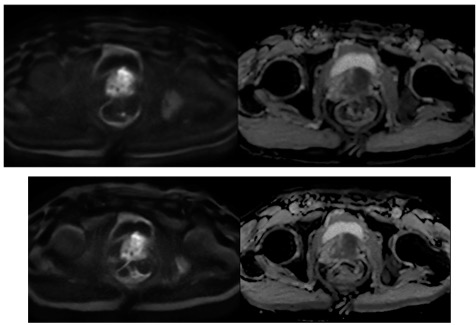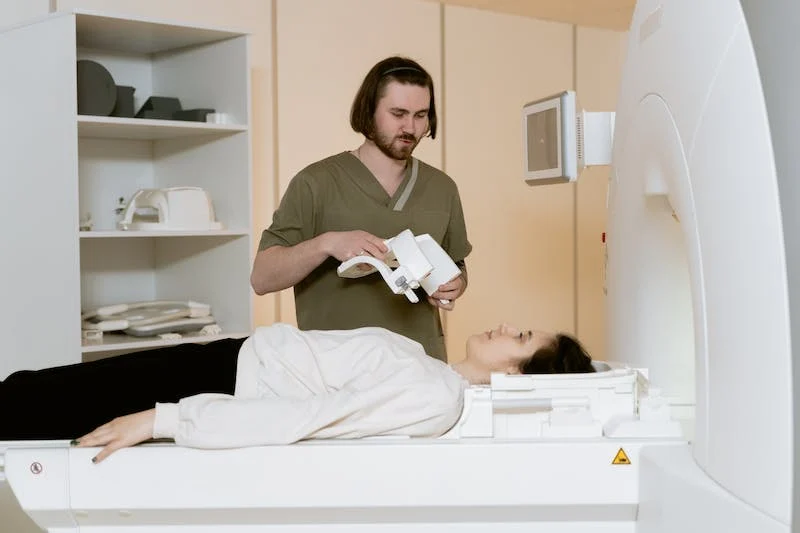【专家述评】| 2022年度前列腺癌基础研究及临床诊疗新进展
2023-08-08 中国癌症杂志 中国癌症杂志 发表于上海
这些成果不断丰富前列腺癌患者的诊治手段,改善其预后。现对2022年度前列腺癌研究领域的重大进展进行综述。
[摘要] 中国初诊的前列腺癌患者中40%~70%已处于转移性疾病阶段,而前列腺癌发生、发展的时空异质性及独特的转移模式使得基于活检组织取材分析免疫标志物的方式困难重重。大量基础与临床研究的推进,使得前列腺癌在发病机制、诊断方法、围手术期处理、放疗技术和晚期疾病的系统治疗等方面取得了新进展。这些成果不断丰富前列腺癌患者的诊治手段,改善其预后。现对2022年度前列腺癌研究领域的重大进展进行综述。
[关键词] 前列腺癌;流行病学;基础研究;临床研究;进展
前列腺癌(prostate cancer,PCa)是全球男性第二大常见癌症和第六大癌症死亡原因。在中国,由于生活方式的改变和人口老龄化,2022年中国PCa的预期患病人数将达到157万,成为威胁男性生命安全的重要因素之一[1]。本文对2022年度PCa研究领域的重大进展进行综述。
1 发病因素
目前已确定的PCa发病影响因素包括遗传因素、种族、身高、肥胖、早熟、高血清水平的睾酮和胰岛素样生长因子1[2]。
PCa是一种具有遗传性的多基因疾病[3],遗传风险与患PCa亲属的人数及亲密程度有关。Brook等[4]研究发现,家族史与PCa特异性生存期之间存在相关性,患者罹患PCa的风险随着确诊亲属数量和亲密度的增加而升高。Clements等[5]研究发现,有PCa或乳腺癌家族史的男性更可能罹患高级别PCa,有一级PCa患者亲属患者,其高级别PCa的发生率是无一级PCa患者亲属患者的1.77倍,且家族史的影响不因前列腺特异性抗原(prostate-specific antigen,PSA)而异,但因年龄而异。BRCA2基因对PCa发病也有一定影响。Li等[6]在校正家族史因素之后,发现相比于不携带BRCA2突变的患者,携带BRCA2突变患者的PCa发病年龄特异性相对风险升高[风险比(hazard ratio,HR)=2.22],且在80岁时,BRCA2携带者罹患PCa的绝对风险为27%。
Zhang等[7]研究发现,每天补充锌超过75 mg和补充锌剂超过15年会显著增加致命性PCa (HR=1.76和1.91)和侵袭性PCa(HR=1.80和1.55)的风险。Yuan等[8]则利用整合三维空间基因组学来识别45个PCa风险等位基因的染色质相互作用靶点,其中31个与565个局限性PCa中靶基因的转录调控相关。
2 基础研究进展
2.1 促进肿瘤进展机制
Shangguan等[9]研究发现,PTEN/TP53缺陷的肿瘤能通过激活固醇调节元件结合蛋白2和抑制磷脂酰肌醇3激酶/蛋白激酶B/糖原合酶激酶-3β(phosphoinositide 3-kinase/protein kinase B/glycogen synthase kinase 3β,PI3K/AKT/GSK3β)介导的蛋白酶体途径上调角鲨烯环氧合酶的表达,进而促进胆固醇生物合成,最终促进肿瘤细胞生长。Fong等[10]研究发现,PALI1在晚期PCa中上调,利用两个中心表观遗传机制来抑制肿瘤细胞的分化,进而促进肿瘤的增殖生长,这个过程可被EZH2和G9A基因的双重靶向抑制阻断。此外,肌酸代谢的增强和缺氧诱导因子2α (hypoxia-inducible factor 2α,HIF2α)的过表达也与PCa细胞的增殖生长有关[11-12]。
2.2 耐药机制
Guan等[13]研究发现,抑制CD8+ T细胞的雄激素受体(androgen receptor,AR)活性可防止T细胞衰竭,并通过增加γ干扰素(interferon-γ,IFN-γ)的表达改善对细胞程序性死亡[蛋白]-1(programmed death-1,PD-1)靶向治疗的响应性。Sena等[14]研究发现,高AR活性能下调MYC表达,进而延长双相雄激素治疗患者的无进展生存期(progression-free survival,PFS)和总生存期(overall survival,OS),因此诱导AR强烈下调可能是该治疗耐药的主要机制。Westbrook等[15]通过对转移性去势抵抗性PCa(castration-resistant PCa,CRPC)肿瘤活检组织的RNA测序发现,含有转录因子E2F1和与肿瘤干性相关通路的肿瘤可能具有由谱系可塑性介导的耐药风险。此外,AR基因的液-液相分离和成型光形态建成蛋白促进转录因子GATA2的降解也能导致AR药物拮抗性的形成[16-17]。
2.3 CPRC的形成
Jeong等[18]研究发现,雄激素剥脱治疗(androgen-deprivation therapy,ADT)期间肿瘤释放的气味结合蛋白捕获CXC族趋化因子配基15 (CXC chemokine ligand 15,CXCL15)/白细胞介素-8(interleukin-8,IL-8),能促进骨髓来源抑制细胞渗入肿瘤微环境,导致CRPC形成。Le等[19]则揭示了DDX5在促进CRPC进展中的关键作用,并提出反义寡核苷酸的靶向抑制与DNA损伤诱导治疗的组合是极具潜力的CRPC治疗新策略。Al-Nakouzi等[20]研究发现,肿瘤细胞糖萼和细胞外基质中硫酸软骨素的表达水平受到AR的调节,能促进AR信号转导抑制剂(AR-signaling inhibitor,ARSI)治疗后CRPC的适应性进展。此外,Cyclin K的下调和乙酰化K13-HOXB13的激活也是CRPC形成的驱动因素[21-22]。
2.4 细胞外囊泡(extracellular vesicle,EV)
癌细胞来源的EV是PCa诊断和预后预测的重要生物标志物。Almeida等[23]对来自同一患者的PCa组织和尿液进行转录组比较,发现了15个EV的长链非编码RNA,为未来的表型表征奠定了基础。Dao等[24]制备了嵌合纳米复合材料,能快速地从尿液中分离EV。Correll等[25]设计了一种差分超离心方法,能在尿液中实现与PCa相关EV常驻蛋白的相对富集,为尿液EV的总体蛋白质组学分析提供了一种有效的手段。Lee等[26]则提出了一种敏感的EV检测方法,仅需约0.2 μL的血液,即可对PCa实现灵敏度和特异度均为100%的诊断。
3 临床研究进展
3.1 诊断方面
早期筛查是PCa治疗的关键,而PSA检测一直是PCa筛查的首选手段。Bryant等[27]研究发现,较高的PSA筛查率与5年后较低的转移性PCa发病率相关。Carlsson等[28]建议PSA筛查应从不迟于55岁开始,因为研究者发现若从更年轻的时候开始PSA筛查,因PCa死亡的风险会降低更多。Godtman等[29]则发现年龄每增加1岁,对比格里森分数(Gleason score,GS)<7的PCa,诊断为GS≥3 +4和≥4+3的风险分别增加11%和8.5%。
一些研究探索了PSA之外的筛查方式。Deng等[30]报道了一种用于检测早期PCa相关生物标志物miR-21的生物传感器,该生物传感器对PCa的灵敏度(100.0%)高于PSA(58.3%)。Nyberg等[31]构建了一个包含268个基因的评分模型,该模型能很好地区分不受影响的男性和5年(C指数=0.790)与10年内(C指数=0.772)诊断PCa的患者。
活检是PCa确诊的金标准。Hugosson等[32]研究发现,对PSA水平升高的患者进行早期检测,并采用磁共振成像(magnetic resonance imaging,MRI)的靶向活检,能显著降低过度诊断的风险。CADMUS试验[33]结果显示,多参数超声检测出的临床显著PCa比多参数MRI少4.3%,但也会导致额外11.1%的患者接受活组织检查,提示多参数超声能替代多参数MRI作为PCa风险患者的首次检查。Wagensveld等[34]研究发现,经超声途径避免的活组织检查少于MRI途径(42% vs 55%),且经超声和MRI途径对级别组(grade group,GG)≥2种癌症的检测效果均较好(25% vs 24%)。Brisbane等[35]则研究发现,约90%的肿瘤位于MRI显示的病变1 cm范围 内。
正电子发射计算机体层成像(positron emission tomography and computed tomography,PET/CT)可提高对PCa转移和复发部位的诊断效能,逐渐被应用于各期PCa的诊断中,尤其是生化复发(biochemically recurrence,BCR)患者中。Ulaner等[36]研究发现,DCFPyL PET/CT对BCR患者的远处转移(74%)和BCR(89%)均有着较高的阳性预测值。Olivier等[37]比较了18F-前列腺特异性膜抗原(prostate-specific membrane antigen,PSMA)-1007与18F-fluorocholine PET/CT在190例BCR患者定位中的诊断价值,发现149例患者因PET/CT检查而改变了诊断结果,其中93例患者的18F-PSMA-1007 PET/CT诊断准确度高于18F-fluorocholine PET/CT。
3.2 治疗方面
3.2.1 手术治疗
扩展盆腔淋巴结清扫术(extended pelvic nodal disp,ePLND)是PCa淋巴结分期的金标准。Gandaglia等[38]在机器人辅助PSMA引导手术(PSMA-radioguided surgery,PSMA-RGS)联合ePLND中,淋巴结的灵敏度、特异度、阳性预测值和阴性预测值分别为67%、100%、100%和90%,证明PSMA-RGS是一种安全可行的手术方式。
一些研究尝试了一些新的术式。Kaouk等[39]在9例GS≤7的PCa患者中,证实单孔经膀胱部分前列腺根治术(radical prostatectomy,RP)是安全可行的,并有望恢复勃起功能。De Barros等[40]研究发现,在使用DROP-IN探针后,PSMA-RGS的灵敏度和特异度分别为86%和100%,提示DROP-IN探针有助于PSMA-RGS。症状性淋巴囊肿是RP合并ePLND最常见的并发症。Student等[41]在一项前瞻性研究中将cT1-2cN0M0患者分为两组:干预组术中将腹膜游离瓣固定在耻骨上,允许淋巴从骨盆引流到腹腔;对照组则游离腹膜瓣,不作固定,结果显示,腹膜固定后可降低症状性淋巴囊肿的发生率(2.4% vs 11.5%)。
3.2.2 放疗
立体定向放射治疗(stereotactic body radiotherapy,SBRT)、调强放射治疗等技术可提高放疗的精度,减少并发症的发生,相关研究也日益深入。Ⅲ期PACE-B试验[42]将低危/中危PCa患者随机分为两组:一组接受标准放疗;另一组患者则接受SBRT,结果显示,SBRT可以缩短患者治疗周期,且不良反应较少。Groen等[43]研究发现,针对前列腺内肿瘤的高剂量特异性治疗可降低复发概率(HR=0.33),且剂量越大,肿瘤复发概率越低。
多项研究探索了联合治疗带来的临床获益。SPPORT试验[44]发现,在SBRT中联合短期ADT是有益的,且应延长挽救性放疗来处理转移性盆腔淋巴结。一项meta分析[45]显示,较高的放疗剂量并不能减少发生转移或死亡的概率,但能降低PSA复发的概率。当剂量增加至79.2 Gy,无论是否联合ADT,均不能改善无远处转移生存期(metastasis-free survival,MFS)。DART 01/05试验[46]则发现,接受大剂量放疗的中危患者不能从长期ADT中获益,且临床决策需要考虑基因组特征。
一些因素与放疗效果有关。Lee等[26]对STOMP和ORIOLE试验中的患者长期随访后发现,与无高危体细胞突变(ATM、BRCA1/2、Rb1或TP53基因)患者相比,存在高危体细胞突变的患者接受SBRT后的PFS更短(P <0.001)。Tilki等[47]在校正ADT的时间依赖性使用和ADT使用时间后,发现对比早期挽救性放疗,辅助放疗与全因死亡率降低有关,且每增加一个阳性盆腔淋巴结,全因死亡率会降低8%。
3.2.3 药物治疗
3.2.3.1 局限期PCa
(1)局限期激素敏感性PCa(hormone-sensitive PCa,HSPC):联合治疗是局限性PCa的治疗趋势。Tran等[48]对比了挽救性放疗联合恩杂鲁胺或安慰剂治疗BCR的患者,发现与安慰剂组相比,恩杂鲁胺治疗组的PSA-PFS得到显著改善(HR=0.42),且2年PSA无进展率更高(84% vs 66%)。ARNEO试验[49]发现,在高危PCa患者中,与单独应用地加瑞克相比,RP前新辅助治疗应用地加瑞克联合阿帕他胺可显著改善微小残留病变(38.0% vs 9.1%)。Ehdaie等[50]采用MRI引导的聚焦超声治疗既往未治疗过的中危PCa患者,发现在接受治疗的89例患者中,78例无2级及以上的高级别PCa复发,提示该方法可用于经筛选过的中风险PCa患者的治疗。
(2)局限期CRPC:随着时间的推移,非转移性CRPC最终会进展为转移性CRPC,因此,探寻更优方式、延缓患者转移的时间至关重要。Bögemann等[51]研究发现,与安慰剂相比,达罗他胺可显著延长非转移性CRPC患者的MFS(HR=0.38),且达罗他胺组的不良反应发生率较低,与安慰剂相似。总体而言,达罗他胺可显著改善患者的MFS和OS,且安全性良好。Pan等[52]纳入了74例在ADT中处于早期去势抵抗阶段的非转移性CRPC(PSA≤2 ng/mL)患者,所有患者接受复合(68Ga-PSMA和18F-FDG)PET/CT扫描后,根据影像学检查结果和后续治疗选择分为PET/CT显像阴性且继续接受ADT组(M-/N-组)、PET/CT显像阳性且继续接受ADT组(ADT组)和PET/CT显像阳性且接受SBRT组(SBRT组),中位随访21.4个月后,M-/N-组和SBRT组的MFS均显著长于ADT组(P <0.001),而M-/N-组和SBRT组的MFS差异无统计学意义,提示PET/CT引导下的非转移性CRPC治疗分型能带来长久的临床获益。
3.2.3.2 转移性PCa
(1)转移性HSPC:转移性HSPC患者平均接受ADT治疗18~24个月后,疾病将进展成转移性CRPC。NCCN指南[53]新增推荐,基于ADT的新型联合治疗是新确诊转移性HSPC患者的标准治疗。PEACE-1试验[54]发现,与多西他赛+ADT相比,阿比特龙+多西他赛+ADT可显著改善患者的影像学PFS(radiographic PFS,rPFS),进展风险降低了50%。一项meta分析[55]结果显示,三联疗法在OS(HR=0.74)和PFS(HR=0.49)方面均优于多西他赛+ADT。ARASENS试验[56]发现,与安慰剂+多西他赛+ADT相比,达罗他胺+多西他赛+ADT降低了转移性HSPC患者32.5%的死亡风险(HR=0.68),延迟了至CRPC的时间(HR=0.36)及疼痛进展时间(HR=0.79)。此外,一些药物为转移性HSPC患者带来了新的治疗选择。CHART研究[57]是一项国际多中心的Ⅲ期临床试验,由复旦大学附属肿瘤医院牵头进行。该研究旨在探索国产原研的第二代ARSI瑞维鲁胺联合ADT对比比卡鲁胺联合ADT在高瘤负荷转移性HSPC患者中的疗效和安全性。结果发现,与对照组相比,瑞维鲁胺组患者的影像学进展风险降低了54%,死亡风险降低了42%。此外,瑞维鲁胺组的严重不良反应发生率与对照组类似。Agarwal等[58]则在一项Ⅲ期临床试验中,评估了在新确诊的转移性HSPC患者联合ADT与非甾体17,20-裂解酶抑制剂Orteronel的临床获益。结果发现,与对照组相比,Orteronel联合ADT治疗组显著延长了PFS(HR=0.58)和7个月时的PSA响应率(P<0.0001),但并未改善OS。
(2)转移性CRPC:85%的转移性CRPC将在2年内死于肿瘤进展[59]。因此,转移性CRPC急需更加有效的治疗策略。PRESIDE临床试验[60]将经恩杂鲁胺治疗后进展且接受多西他赛治疗的转移性CRPC随机分配至安慰剂组和继续恩杂鲁胺治疗组,发现联合恩杂鲁胺能显著延长患者的PFS(P=0.027)。2022年3月,177Lu-PSMA-617被批准用于治疗已经接受过ARSI和基于紫杉烷类药物化疗且存在PSMA阳性病灶的转移性CRPC患者,为转移性CRPC患者提供了新的治疗选择。Ⅲ期研究VISION[61]的后续报道提示,接受177Lu-PSMA-617治疗后,与PSA未下降的患者相比,PSA最大降幅为50%~90%和>90%患者的影像学疾病进展风险分别降低了80%和96%,死亡风险分别降低了58%和90%。免疫治疗也可用于转移性CRPC患者。在1b/2期KEYNOTE-365研究A队列[62]中,患者接受palivizumab联合奥拉帕利后,中位rPFS为4.5个月,中位OS为14个月。而B队列[63]纳入了既往接受过ARSI且未接受过多西他赛化疗的转移性CRPC患者,palivizumab联合多西他赛治疗后中位rPFS和OS分别为8.5和20.2个月。两项试验均提示palivizumab的联合治疗有着良好的抗肿瘤活性。Ⅲ期MAGNITUDE试验[64]的分析结果显示,在存在同源重组修复(homologous recombination repair,HRR)基因突变的患者中,与安慰剂+阿比特龙相比,尼拉帕利+阿比特龙使所有HRR基因突变患者的进展风险降低了27%,并推迟了首次症状性骨骼事件时间。Fizazi等[65]报告了CheckMate 9KD试验中A1和A2队列的分析结果,发现无论患者是否接受过化疗,纳武利尤单抗联合鲁卡帕尼的治疗均能给HRR缺陷的患者带来客观缓解率和PSA缓解率的获益。Agarwal等[66]发现,联合多受体酪氨酸激酶抑制剂卡博替尼和阿替利珠单抗在接受ARSI后影像学进展的转移性CRPC患者中显示出良好的抗肿瘤活性和可接受的安全性。一些研究探索了新的治疗方案。Kim等[67]研究发现,与单独使用奥拉帕尼相比,联合泛血管内皮生长因子受体抑制剂西地尼布和奥拉帕尼可改善转移性CRPC男性患者的rPFS(HR=0.62)。在Ⅰ期人体试验中,Narayan等[68]研究发现,抗转化生长因子-β的嵌合抗原受体T细胞的临床应用是可行且普遍安全的。Lake等[69]合成了一组能介导增强对低抗原表达靶细胞的抗癌免疫功能的聚合抗体招募分子,为转移性CRPC的免疫治疗提供了新的思路。
4 总结与展望
PCa的预后改善依赖于基础研究、转化研究和临床研究的共同发展。目前,PCa的治疗选择越来越多。未来,随着对PCa分子生物学特性和临床转化研究的深入,PCa的耐药机制将得到更为清晰的阐述,诊治手段将日益丰富,最终将进一步改善PCa患者的预后。
利益冲突声明:所有作者均声明不存在利益冲突。
[参考文献]
[1] DÖRR M, HÖLZEL D, SCHUBERT-FRITSCHLE G, et al. Changes in prognostic and therapeutic parameters in prostate cancer from an epidemiological view over 20 years[J]. Oncol Res Treat, 2015, 38(1/2): 8-14.
[2] UGAI T, SASAMOTO N, LEE H Y, et al. Is early-onset cancer an emerging global epidemic? Current evidence and future implications[J]. Nat Rev Clin Oncol, 2022, 19(10): 656-673.
[3] HJELMBORG J B, SCHEIKE T, HOLST K, et al. The heritability of prostate cancer in the Nordic twin study of cancer[J]. Cancer Epidemiol Biomarkers Prev, 2014, 23(11): 2303-2310.
[4] BROOK M N, NÍ RAGHALLAIGH H, GOVINDASAMI K, et al. Family history of prostate cancer and survival outcomes in the UK genetic prostate cancer study[J]. Eur Urol, 2023, 83(3): 257-266.
[5] CLEMENTS M B, VERTOSICK E A, GUERRIOS-RIVERA L, et al. Defining the impact of family history on detection of highgrade prostate cancer in a large multi-institutional cohort[J]. Eur Urol, 2022, 82(2): 163-169.
[6] LI S, SILVESTRI V, LESLIE G, et al. Cancer risks associated with BRCA1 and BRCA2 pathogenic variants[J]. J Clin Oncol, 2022, 40(14): 1529-1541.
[7] ZHANG Y W, SONG M Y, MUCCI L A, et al. Zinc supplement use and risk of aggressive prostate cancer: a 30-year follow-up study[J]. Eur J Epidemiol, 2022, 37(12): 1251-1260.
[8] YUAN J P, HOULAHAN K E, RAMANAND S G, et al. Prostate cancer transcriptomic regulation by the interplay of germline risk alleles, somatic mutations, and 3D genomic architecture[J]. Cancer Discov, 2022, 12(12): 2838-2855.
[9] SHANGGUAN X, MA Z H, YU M H, et al. Squalene epoxidase metabolic dependency is a targetable vulnerability in castrationresistant prostate cancer[J]. Cancer Res, 2022, 82(17): 3032-3044.
[10] FONG K W, ZHAO J C, LU X D, et al. PALI1 promotes tumor growth through competitive recruitment of PRC2 to G9A-target chromatin for dual epigenetic silencing[J]. Mol Cell, 2022, 82(24): 4611-4626.e7.
[11] PATEL R, FORD C A, RODGERS L, et al. Cyclocreatine suppresses creatine metabolism and impairs prostate cancer progression[J]. Cancer Res, 2022, 82(14): 2565-2575.
[12] QIN L, CHUNG Y M, BERK M, et al. Hypoxia-reoxygenation couples 3βHSD1 enzyme and cofactor upregulation to facilitate androgen biosynthesis and hormone therapy resistance in prostate cancer[J]. Cancer Res, 2022, 82(13): 2417-2430.
[13] GUAN X N, POLESSO F, WANG C J, et al. Androgen receptor activity in T cells limits checkpoint blockade efficacy[J]. Nature, 2022, 606(7915): 791-796.
[14] SENA L A, KUMAR R, SANIN D E, et al. Androgen receptor activity in prostate cancer dictates efficacy of bipolar androgen therapy through MYC[J]. J Clin Invest, 2022, 132(23): e162396.
[15] WESTBROOK T C, GUAN X N, RODANSKY E, et al. Transcriptional profiling of matched patient biopsies clarifies molecular determinants of enzalutamide-induced lineage plasticity[J]. Nat Commun, 2022, 13(1): 5345.
[16] XIE J J, HE H, KONG W N, et al. Targeting androgen receptor phase separation to overcome antiandrogen resistance[J]. Nat Chem Biol, 2022, 18(12): 1341-1350.
[17] SHEN T, DONG B N, MENG Y L, et al. A COP1-GATA2 axis suppresses AR signaling and prostate cancer[J]. Proc Natl Acad Sci U S A, 2022, 119(43): e2205350119.
[18] JEONG J H, ZHONG S W, LI F Z, et al. Tumor-derived OBP2A promotes prostate cancer castration resistance[J]. J Exp Med, 2023, 220(3): e20211546.
[19] LE T K, CHERIF C, OMABE K, et al. DDX5 mRNA-targeting antisense oligonucleotide as a new promising therapeutic in combating castration-resistant prostate cancer[J]. Mol Ther, 2023, 31(2): 471-486.
[20] AL-NAKOUZI N, WANG C K, OO H Z, et al. Reformation of the chondroitin sulfate glycocalyx enables progression of ARindependent prostate cancer[J]. Nat Commun, 2022, 13(1): 4760.
[21] SUN R, WEI T, DING D L, et al. CYCLIN K down-regulation induces androgen receptor gene intronic polyadenylation, variant expression and PARP inhibitor vulnerability in castrationresistant prostate cancer[J]. Proc Natl Acad Sci U S A, 2022, 119(39): e2205509119.
[22] NGUYEN D T, YANG W, RENGANATHAN A, et al. Acetylated HOXB13 regulated super enhancer genes define therapeutic vulnerabilities of castration-resistant prostate cancer[J]. Clin Cancer Res, 2022, 28(18): 4131-4145.
[23] ALMEIDA A, GABRIEL M, FIRLEJ V, et al. Urinary extracellular vesicles contain mature transcriptome enriched in circular and long noncoding RNAs with functional significance in prostate cancer[J]. J Extracell Vesicles, 2022, 11(5): e12210.
[24] DAO T N T, KIM M G, KOO B, et al. Chimeric nanocomposites for the rapid and simple isolation of urinary extracellular vesicles[J]. J Extracell Vesicles, 2022, 11(2): e12195.
[25] CORRELL V L, OTTO J J, RISI C M, et al. Optimization of small extracellular vesicle isolation from expressed prostatic secretions in urine for in-depth proteomic analysis[J]. J Extracell Vesicles, 2022, 11(2): e12184.
[26] LEE E, SHIN S, YIM S G, et al. Sessile droplet array for sensitive profiling of multiple extracellular vesicle immunosubtypes[J]. Biosens Bioelectron, 2022, 218: 114760.
[27] BRYANT A K, LEE K M, ALBA P R, et al. Association of prostate-specific antigen screening rates with subsequent metastatic prostate cancer incidence at US veterans health administration facilities[J]. JAMA Oncol, 2022, 8(12): 1747-1755.
[28] CARLSSON S V, ARNSRUD GODTMAN R, PIHL C G, et al. Young age on starting prostate-specific antigen testing is associated with a greater reduction in prostate cancer mortality: 24-year follow-up of the göteborg randomized populationbased prostate cancer screening trial[J]. Eur Urol, 2023, 83(2): 103-109.
[29] GODTMAN R A, KOLLBERG K S, PIHL C G, et al. The association between age, prostate cancer risk, and higher gleason score in a long-term screening program: results from the göteborg-1 prostate cancer screening trial[J]. Eur Urol, 2022, 82(3): 311-317.
[30] DENG M H, REN Z P, ZHANG H B, et al. Unamplified and real-time label-free miRNA-21 detection using solution-gated graphene transistors in prostate cancer diagnosis[J]. Adv Sci (Weinh), 2023, 10(4): e2205886.
[31] NYBERG T, BROOK M N, FICORELLA L, et al. CanRiskprostate: a comprehensive, externally validated risk model for the prediction of future prostate cancer[J]. J Clin Oncol, 2023, 41(5): 1092-1104.
[32] HUGOSSON J, MÅNSSON M, WALLSTRÖM J, et al. Prostate cancer screening with PSA and MRI followed by targeted biopsy only[J]. N Engl J Med, 2022, 387(23): 2126-2137.
[33] GREY A D R, SCOTT R, SHAH B, et al. Multiparametric ultrasound versus multiparametric MRI to diagnose prostate cancer (CADMUS): a prospective, multicentre, paired-cohort, confirmatory study[J]. Lancet Oncol, 2022, 23(3): 428-438.
[34] WAGENSVELD I M, OSSES D F, GROENENDIJK P M, et al. A prospective multicenter comparison study of risk-adapted ultrasound-directed and magnetic resonance imaging-directed diagnostic pathways for suspected prostate cancer in biopsynaïve men[J]. Eur Urol, 2022, 82(3): 318-326.
[35] BRISBANE W G, PRIESTER A M, BALLON J, et al. Targeted prostate biopsy: umbra, penumbra, and value of perilesional sampling[J]. Eur Urol, 2022, 82(3): 303-310.
[36] ULANER G A, THOMSEN B, BASSETT J, et al. 18F-DCFPyL PET/CT for initially diagnosed and biochemically recurrent prostate cancer: prospective trial with pathologic confirmation[J]. Radiology, 2022, 305(2): 419-428.
[37] OLIVIER P, GIRAUDET A L, SKANJETI A, et al. Phase Ⅲ study of 18F-PSMA-1007 versus 18F-fluorocholine PET/CT for localization of prostate cancer biochemical recurrence: a prospective, randomized, cross-over, multicenter study[J]. J Nucl Med, 2022: jnumed.122.264743.
[38] GANDAGLIA G, MAZZONE E, STABILE A, et al. Prostatespecific membrane antigen radioguided surgery to detect nodal metastases in primary prostate cancer patients undergoing robot-assisted radical prostatectomy and extended pelvic lymph node disp: results of a planned interim analysis of a prospective phase 2 study[J]. Eur Urol, 2022, 82(4): 411-418.
[39] KAOUK J H, FERGUSON E L, BEKSAC A T, et al. Single-port robotic transvesical partial prostatectomy for localized prostate cancer: initial series and description of technique[J]. Eur Urol, 2022, 82(5): 551-558.
[40] DE BARROS H A, VAN OOSTEROM M N, DONSWIJK M L, et al. Robot-assisted prostate-specific membrane antigenradioguided salvage surgery in recurrent prostate cancer using a DROP-IN gamma probe: the first prospective feasibility study[J]. Eur Urol, 2022, 82(1): 97-105.
[41] STUDENT V JR, TUDOS Z, STUDENTOVA Z, et al. Effect of peritoneal fixation (PerFix) on lymphocele formation in robotassisted radical prostatectomy with pelvic lymphadenectomy: results of a randomized prospective trial[J]. Eur Urol, 2023, 83(2): 154-162.
[42] TREE A C, OSTLER P, VAN DER VOET H, et al. Intensitymodulated radiotherapy versus stereotactic body radiotherapy for prostate cancer (PACE-B): 2-year toxicity results from an open-label, randomised, phase 3, non-inferiority trial[J]. Lancet Oncol, 2022, 23(10): 1308-1320.
[43] GROEN V H, HAUSTERMANS K, POS F J, et al. Patterns of failure following external beam radiotherapy with or without an additional focal boost in the randomized controlled FLAME trial for localized prostate cancer[J]. Eur Urol, 2022, 82(3): 252-257.
[44] POLLACK A, KARRISON T G, BALOGH A G, et al. The addition of androgen deprivation therapy and pelvic lymph node treatment to prostate bed salvage radiotherapy (NRG Oncology/RTOG 0534 SPPORT): an international, multicentre, randomised phase 3 trial[J]. Lancet, 2022, 399(10338): 1886-1901.
[45] AMAR U, KISHAN, . High-dose radiotherapy or androgen deprivation therapy (HEAT) as treatment intensification for localized prostate cancer: an individual patient-data network meta-analysis from the MARCAP consortium[J]. Eur Urol, 2022, 82(1): 106-114.
[46] ZAPATERO A, GUERRERO A, MALDONADO X, et al. Highdose radiotherapy and risk-adapted androgen deprivation in localised prostate cancer (DART 01/05): 10-year results of a phase 3 randomised, controlled trial[J]. Lancet Oncol, 2022, 23(5): 671-681.
[47] TILKI D, CHEN M H, WU J, et al. Adjuvant versus early salvage radiation therapy after radical prostatectomy for pN1 prostate cancer and the risk of death[J]. J Clin Oncol, 2022, 40(20): 2186-2192.
[48] TRAN P T, LOWE K, TSAI H L, et al. Phase Ⅱ randomized study of salvage radiation therapy plus enzalutamide or placebo for high-risk prostate-specific antigen recurrent prostate cancer after radical prostatectomy: the SALV-ENZA trial[J]. J Clin Oncol, 2023, 41(6): 1307-1317.
[49] DEVOS G, TOSCO L, BALDEWIJNS M, et al. ARNEO: a randomized phase Ⅱ trial of neoadjuvant degarelix with or without apalutamide prior to radical prostatectomy for high-risk prostate cancer[J]. Eur Urol, 2022: S0302-S2838(22)02638-0.
[50] EHDAIE B, TEMPANY C M, HOLLAND F, et al. MRI-guided focused ultrasound focal therapy for patients with intermediaterisk prostate cancer: a phase 2b, multicentre study[J]. Lancet Oncol, 2022, 23(7): 910-918.
[51] BÖGEMANN M, SHORE N D, SMITH M R, et al. Erratum to “efficacy and safety of darolutamide in patients with nonmetastatic castration-resistant prostate cancer stratified by prostate-specific antigen doubling time: Planned subgroup analysis of the phase 3 ARAMIS trial”[J]. Eur Urol, 2023, 83(2): e60.
[52] PAN J, WEI Y, ZHANG T, et al . Stereotactic radiotherapy for lesions detected via 68Ga-prostate-specific membrane antigen and 18F-fluorodexyglucose positron emission tomography/ computed tomography in patients with nonmetastatic prostate cancer with early prostate-specific antigen progression on androgen deprivation therapy: a prospective single-center study[J]. Eur Urol Oncol, 2022, 5(4): 420-427.
[53] SCHAEFFER E M, SRINIVAS S, ADRA N, et al. NCCN guidelines® insights: prostate cancer, version 1.2023[J]. J Natl Compr Canc Netw, 2022, 20(12): 1288-1298.
[54] FIZAZI K, FOULON S, CARLES J, et al. Abiraterone plus prednisone added to androgen deprivation therapy and docetaxel in de novo metastatic castration-sensitive prostate cancer (PEACE-1): a multicentre, open-label, randomised, phase 3 study with a 2 ×2 factorial design[J]. Lancet, 2022, 399(10336): 1695-1707.
[55] YANAGISAWA T, RAJWA P, THIBAULT C, et al. Androgen receptor signaling inhibitors in addition to docetaxel with androgen deprivation therapy for metastatic hormone-sensitive prostate cancer: a systematic review and meta-analysis[J]. Eur Urol, 2022, 82(6): 584-598.
[56] ARMSTRONG A J, AZAD A A, IGUCHI T, et al. Improved survival with enzalutamide in patients with metastatic hormonesensitive prostate cancer[J]. J Clin Oncol, 2022, 40(15): 1616-1622.
[57] GU W J, HAN W Q, LUO H, et al. Rezvilutamide versus bicalutamide in combination with androgen-deprivation therapy in patients with high-volume, metastatic, hormone-sensitive prostate cancer (CHART): a randomised, open-label, phase 3 trial[J]. Lancet Oncol, 2022, 23(10): 1249-1260.
[58] AGARWAL N, TANGEN C M, HUSSAIN M H A, et al. Orteronel for metastatic hormone-sensitive prostate cancer: a multicenter, randomized, open-label phase Ⅲ trial (SWOG-1216)[J]. J Clin Oncol, 2022, 40(28): 3301-3309.
[59] SAAD F, STERNBERG C N, EFSTATHIOU E, et al. Prostatespecific antigen progression in enzalutamide-treated men with nonmetastatic castration-resistant prostate cancer: any rise in prostate-specific antigen may require closer monitoring[J]. Eur Urol, 2020, 78(6): 847-853.
[60] MERSEBURGER A S, ATTARD G, ÅSTRÖM L, et al. Continuous enzalutamide after progression of metastatic castration-resistant prostate cancer treated with docetaxel (PRESIDE): an international, randomised, phase 3b study[J]. Lancet Oncol, 2022, 23(11): 1398-1408.
[61] SARTOR O, DE BONO J, CHI K N, et al. Lutetium-177- PSMA-617 for metastatic castration-resistant prostate cancer[J]. N Engl J Med, 2021, 385(12): 1091-1103.
[62] YU E Y, PIULATS J M, GRAVIS G, et al. Pembrolizumab plus olaparib in patients with metastatic castration-resistant prostate cancer: long-term results from the phase 1b/2 KEYNOTE-365 cohort A study[J]. Eur Urol, 2023, 83(1): 15-26.
[63] YU E Y, KOLINSKY M P, BERRY W R, et al. Pembrolizumab plus docetaxel and prednisone in patients with metastatic castration-resistant prostate cancer: long-term results from the phase 1b/2 KEYNOTE-365 cohort B study[J]. Eur Urol, 2022, 82(1): 22-30.
[64] CHI K N, RATHKOPF D, SMITH M R, et al. Niraparib and abiraterone acetate for metastatic castration-resistant prostate cancer [J]. J Clin Oncol, 2022. [Online ahead of print]
[65] FIZAZI K, RETZ M, PETRYLAK D P, et al. Nivolumab plus rucaparib for metastatic castration-resistant prostate cancer: results from the phase 2 CheckMate 9KD trial[J]. J Immunother Cancer, 2022, 10(8): e004761.
[66] AGARWAL N, MCGREGOR B, MAUGHAN B L, et al. Cabozantinib in combination with atezolizumab in patients with metastatic castration-resistant prostate cancer: results from an expansion cohort of a multicentre, open-label, phase 1b trial (COSMIC-021)[J]. Lancet Oncol, 2022, 23(7): 899-909.
[67] KIM J W, MCKAY R R, RADKE M R, et al. Randomized trial of olaparib with or without cediranib for metastatic castrationresistant prostate cancer: the results from national cancer institute 9984[J]. J Clin Oncol, 2023, 41(4): 871-880.
[68] NARAYAN V, BARBER-ROTENBERG J S, JUNG I Y, et al. PSMA-targeting TGFβ-insensitive armored CAR T cells in metastatic castration-resistant prostate cancer: a phase 1 trial[J]. Nat Med, 2022, 28(4): 724-734.
[69] LAKE B P M, WYLIE R G, BAŘINKA C, et al. Tunable multivalent platform for immune recruitment to lower antigen expressing cancers[J]. Angew Chem Int Ed Engl, 2023, 62(9): e202214659.
本网站所有内容来源注明为“梅斯医学”或“MedSci原创”的文字、图片和音视频资料,版权均属于梅斯医学所有。非经授权,任何媒体、网站或个人不得转载,授权转载时须注明来源为“梅斯医学”。其它来源的文章系转载文章,或“梅斯号”自媒体发布的文章,仅系出于传递更多信息之目的,本站仅负责审核内容合规,其内容不代表本站立场,本站不负责内容的准确性和版权。如果存在侵权、或不希望被转载的媒体或个人可与我们联系,我们将立即进行删除处理。
在此留言













